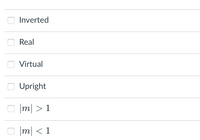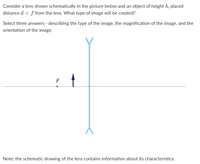
College Physics
11th Edition
ISBN: 9781305952300
Author: Raymond A. Serway, Chris Vuille
Publisher: Cengage Learning
expand_more
expand_more
format_list_bulleted
Concept explainers
Question

Transcribed Image Text:Inverted
Real
O Virtual
Upright
O
|m| > 1
|m| < 1

Transcribed Image Text:Consider a lens shown schematically in the picture below and an object of height h, placed
distance d < f from the lens. What type of image will be created?
Select three answers - describing the type of the image, the magnification of the image, and the
orientation of the image.
F
Note: the schematic drawing of the lens contains information about its characteristics.
Expert Solution
This question has been solved!
Explore an expertly crafted, step-by-step solution for a thorough understanding of key concepts.
This is a popular solution
Trending nowThis is a popular solution!
Step by stepSolved in 2 steps with 2 images

Knowledge Booster
Learn more about
Need a deep-dive on the concept behind this application? Look no further. Learn more about this topic, physics and related others by exploring similar questions and additional content below.Similar questions
- please answer parts b, c, and darrow_forwardCan you please help with the attached question? Thanks!arrow_forwardAn object is 12.0 cm from a converging lens (focal length = 15.0 cm). Determine the image magnification. Enter the numerical part of your answer to two significant figures. Hint: Remember that the sign of the magnification is significant.arrow_forward
- A converging lens has a focal length of 4.0 cm A 1.5 cm object is placed 6.0 cm to the left of the lens (as shown in the diagram below) Part A The distance of the image will be ανα ΑΣφ d; = cm Submit Request Answer Part B The height of the image will be Πνη ΑΣφ ? h4 = cm Submit Request Answer Part C The image is and O real, upright O real, inverted O virtual, inverted O virtual, uprightarrow_forwardThin lenses. Object O stands on the central axis of a thin symmetric lens. For this situation, each problem in the table (below) gives object distance p (centimeters), the type of lens (C stands for converging and D for diverging), and then the distance (centimeters, without proper sign) between a focal point and the lens. Find (a) the image distance i and (b) the lateral magnification m of the object, including signs. Also, determine whether the image is (c) real or virtual, (d) inverted from object O or noninverted, and (e) on the same side of the lens as object O or on the opposite side. (a) (b) (c) (d) (e) Lens i m R/V I/NI Side +14 C, 24 (a) Number Units (b) Number i Units (c) (d) (e) > >arrow_forwardChapter 34, Problem 011 Spherical mirrors. Object O stands on the central axis of a spherical mirror. For this situation object distance is ps = +12 cm, the type of mirror is convex, and then the distance between the focal point and the mirror is 15 cm (without proper sign). Find (a) the radius of curvature r (including sign), (b) the image distance i, and (c) the lateral magnification m. Also, determine whether the image is (d) real or virtual, (e) inverted from object O or noninverted, and (f) on the same side of the mirror as O or on the opposite side. (a) Number Units (b) Number Units (c) Number Units (p) (e) (f)arrow_forward
- Case 5: Object located in focus (d0= F'). The figure below shows an arrow-shaped object, placed in front of a convex lens at a distance d0 equal to a focal length (d0=F'). Draw the following rays in the figure: ray parallel to the optical axis, central ray. Don't forget to put the direction on each ray, both the incident rays and the transmitted rays. Label each ray with its name. Image characteristics for Case 5: Object located in focus (d0= F'). Choose the ones that apply: a) Virtual b) Real c) Inverted d) Increased e) No image is formed f) Equal size g) Reduced h) Erect Case 6: Object located between the focus and the vertex of a convex lens (d0< F'). The figure below shows an arrow-shaped object, placed in front of a convex lens at a distance d0 less than a focal length (d0<F'). Draw the following rays in the figure: ray parallel to the optical axis, focal ray, central ray. Draw the image of the arrow, indicate in the same figure from where to where di is (image-lens…arrow_forwardPlease help me solve the following.arrow_forward
arrow_back_ios
arrow_forward_ios
Recommended textbooks for you
 College PhysicsPhysicsISBN:9781305952300Author:Raymond A. Serway, Chris VuillePublisher:Cengage Learning
College PhysicsPhysicsISBN:9781305952300Author:Raymond A. Serway, Chris VuillePublisher:Cengage Learning University Physics (14th Edition)PhysicsISBN:9780133969290Author:Hugh D. Young, Roger A. FreedmanPublisher:PEARSON
University Physics (14th Edition)PhysicsISBN:9780133969290Author:Hugh D. Young, Roger A. FreedmanPublisher:PEARSON Introduction To Quantum MechanicsPhysicsISBN:9781107189638Author:Griffiths, David J., Schroeter, Darrell F.Publisher:Cambridge University Press
Introduction To Quantum MechanicsPhysicsISBN:9781107189638Author:Griffiths, David J., Schroeter, Darrell F.Publisher:Cambridge University Press Physics for Scientists and EngineersPhysicsISBN:9781337553278Author:Raymond A. Serway, John W. JewettPublisher:Cengage Learning
Physics for Scientists and EngineersPhysicsISBN:9781337553278Author:Raymond A. Serway, John W. JewettPublisher:Cengage Learning Lecture- Tutorials for Introductory AstronomyPhysicsISBN:9780321820464Author:Edward E. Prather, Tim P. Slater, Jeff P. Adams, Gina BrissendenPublisher:Addison-Wesley
Lecture- Tutorials for Introductory AstronomyPhysicsISBN:9780321820464Author:Edward E. Prather, Tim P. Slater, Jeff P. Adams, Gina BrissendenPublisher:Addison-Wesley College Physics: A Strategic Approach (4th Editio...PhysicsISBN:9780134609034Author:Randall D. Knight (Professor Emeritus), Brian Jones, Stuart FieldPublisher:PEARSON
College Physics: A Strategic Approach (4th Editio...PhysicsISBN:9780134609034Author:Randall D. Knight (Professor Emeritus), Brian Jones, Stuart FieldPublisher:PEARSON

College Physics
Physics
ISBN:9781305952300
Author:Raymond A. Serway, Chris Vuille
Publisher:Cengage Learning

University Physics (14th Edition)
Physics
ISBN:9780133969290
Author:Hugh D. Young, Roger A. Freedman
Publisher:PEARSON

Introduction To Quantum Mechanics
Physics
ISBN:9781107189638
Author:Griffiths, David J., Schroeter, Darrell F.
Publisher:Cambridge University Press

Physics for Scientists and Engineers
Physics
ISBN:9781337553278
Author:Raymond A. Serway, John W. Jewett
Publisher:Cengage Learning

Lecture- Tutorials for Introductory Astronomy
Physics
ISBN:9780321820464
Author:Edward E. Prather, Tim P. Slater, Jeff P. Adams, Gina Brissenden
Publisher:Addison-Wesley

College Physics: A Strategic Approach (4th Editio...
Physics
ISBN:9780134609034
Author:Randall D. Knight (Professor Emeritus), Brian Jones, Stuart Field
Publisher:PEARSON